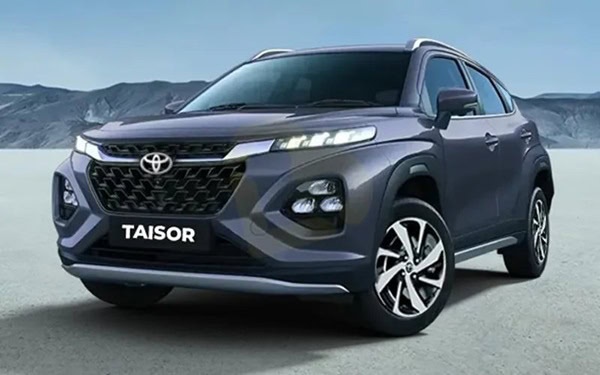
A lot of good and bad things are said about the badge re-engineering between Maruti Suzuki and Toyota. But the fact is that both the companies are selling their cars in good numbers. Let us look at the all new Toyota Urban Cruiser Taisor which is essentially the Maruti Suzuki Fronx.
The Urban Cruiser Taisor gets the same engine options as the Maruti Suzuki Fronx which are: an 89 BHP 1.2L 4-cylinder naturally-aspirated petrol mated to a 5-speed MT or 5-speed AMT and a 99 BHP 1.0L 3-cylinder turbocharged petrol with a Smart Hybrid system mated to a 5-speed MT or 6-speed AT. There’s also a CNG option available with the 1.2L naturally aspirated petrol engine. And while the cars are almost identical, there are some differences between the Toyota and the Maruti, so let’s get started.
Price
The Toyota Urban Cruiser Taisor is available in six variants with prices starting from Rs 7.74 lakh and going up to Rs. 13.04 lakh (ex-showroom). The price difference for the variants with the naturally aspirated engine is roughly Rs. 22,000 but the variants with the turbo-petrol engine have the same price. The Toyota Urban Cruiser Taisor is offered with a standard warranty of 3 years / 1,00,000 km while the Fronx has a standard warranty of 2 years / 40,000 km. However, note that both offer extended coverage for up to 5 years (Fronx – 1,00,000 km & Taisor – 2,20,000 km).
In all fairness, there’s very little that differentiates the two cars. And if you had to pick one from the Maruti Fronx or the Toyota Urban Cruiser Taisor, it would boil down to your preferred manufacturer among the two.
Exterior
Toyota has done a decent job of distinguishing itself from the Maruti Suzuki Fronx. It has a simpler design with less chrome and more subtle creases on the front bumper when compared to the Fronx. The rear although is almost identical to the Fronx barring the taillamp design. The design of the alloy wheels is however different and the 5-petal design looks good on the Taisor. It 3,995 mm in length, 1,765 mm in width, 1,550 mm in height and has a wheelbase of 2,520 mm. The Lucent Orange paint shade is the one which you won’t get on the Fronx. Other mono-tone colours include Sportin Red, Cafe White, Enticing Silver and Gaming Grey. A slim chrome strip joins the two DRLs and you get a honeycomb mesh front grille. The design looks a lot more subtle and classy compared to the Fronx. Also to note that the bumper creases are not as aggressive as they are on the Fronx. The DRL design is simple and looks nice on the Taisor. The headlamp cluster has been carried over from the Fronx. ORVMs get integrated LED turn-indicators and cameras underneath for the 360-degree view system. The machined cut alloys are available only on the top-end ‘V’ variant and IMO, they look better than the ones on the Fronx. Disc brakes on the Front and drums at the rear. LED taillamp design is sleeker than Fronx’s design. The bumper gets plenty of creases along with a black insert and a large silver skid plate. You also get a variant badge on the car and below that is the ‘neoDrive’ which is the smart hybrid version. There is also the roof spoiler also houses the High Mount Stop Lamp and the roof gets a Dual-tone paint options which are available only with the Sporting Red, Enticing Silver and Café White colours.
Interior
Inside the cabin, it is exactly what you get in the Maruti Fronx. Of course instead of the Suzuki logo on the steering wheel, you get the Toyota logo. On the automatic variant, you get paddle shifters. These are well-sized, properly placed and are good fun to use as well. The instrument cluster is the same as the Fronx. However, you don’t get the ‘Smart Hybrid’ symbol in the speedometer from the Maruti Suzuki. Would’ve been nice if Toyota would’ve added a ‘neo Drive’ symbol here. The Transmission mode for the automatic variant, is displayed in the bottom corner of the MID. You don’t get to see the engaged gear in ‘D’ mode. Switch to Manual mode and you get the gear selected on the display. Fabric-upholstered front seats get side airbags too (no seat covers here please). We would’ve liked to see ventilated seats here. Overall, the seats offer sufficient bolstering & back support. The pedals are well-spaced and the dead pedal is very much usable. The touchscreen is very smooth to use and doesn’t lag when you are going through its functions. It is one of the nicer units in the segment and comes with wireless Android Auto and Apple CarPlay connectivity along with wireless charging integrated in the console. The automatic gearbox does not have an “L” or “2” mode. Instead, you get an “M” mode which has been placed right below the D mode. You will end up engaging M mode instead of D. The modes aren’t backlit as well, so you don’t know what mode has been engaged. The UV-cut glass is a great feature for this segment which is a boon in summers and the car cools very quickly. The rear bench gets 3 adjustable headrests and all 3 occupants get 3-point seatbelts. Annoyingly, since there are no load sensors for the rear seats, all seatbelts need to be buckled in when the car is being driven even if no one is sitting on the seats to prevent the seatbelt warning from sounding. A centre armrest has not been provided. Boot space is rated at 308 litres, which is among the smallest in the segment. Even the Baleno has a larger boot (318 litres). Boot lamp has been provided on the left.
Mileage & Fuel Economy
The 1.2L naturally aspirated petrol has an ARAI-certified fuel efficiency of 21.71 km/l for the MT and 22.79 km/l for the AMT.
